Genesis and Accumulation Period of CO2 Gas Reservoir in Hailar Basin
Abstract
:1. Introduction
2. Regional Geological Background
3. Genetic Analysis of CO2 Gas Reservoir
3.1. CO2 Content Analysis
3.2. Carbon Isotope Analysis
3.3. Helium and Argon Isotope Analysis
4. Controlling Factors
- (1)
- Magmatic rock mass provides gas source conditions for the formation of inorganic CO2 gas
- (2)
- Deep faults provide the main channels of CO2 gas migration
- (3)
- Reservoir physical properties and caprock have a certain control over the enrichment of CO2 gas
5. Discussion
6. Conclusions
- Natural gas reservoirs with a high CO2 content have been found in many wells in the Hailar Basin. The CO2 content is more than 90%, except for in Wu 13. The stable carbon isotope is distributed in the range of −13.6~−1.4‰, and the 3He/4He value of rare gas helium isotope is 1.68 × 10−6~2.08 × 10−6. The R/Ra value is 1.2~1.49; the 40Ar/36Ar values of noble gas argon isotopes are 289~996. The above comprehensive analysis shows that the CO2 gas in the Hailar Basin is inorganic gas, which generally has the characteristics of crust–mantle-mixed CO2 gas, and the fraction of mantle-derived helium can reach 15.12–18.76%. CO2 gas mainly comes from the deep crust and is related to deep faults and magmatic rock mass activities.
- The distribution of CO2 gas reservoirs in the Hailar Basin is mainly controlled by the distribution of deep faults and volcanic rocks, as well as the reservoirs’ physical properties and preservation conditions. Magmatic rock mass provides gas source conditions for the formation of inorganic CO2 gas reservoirs. Deep faults provide the main channels of CO2 gas migration. The sandy conglomerate of the Nantun Formation and Tongbomiao Formation provides favorable reservoir space for the formation of CO2 gas reservoirs. The overlying mudstone of the Nantun Formation and Damoguaihe Formation has a good regional caprock. The composite part of the volcanic rock mass and deep fault is a favorable CO2 gas accumulation area.
- The age of magmatic intrusion and the homogenization temperature of oil–gas inclusions in the oil-bearing sandstones indicate that the initial degassing period of CO2 gas was 120 Ma in the Early Cretaceous, which was the peak of magmatic activity in Northeast China and the period of great crustal changes in Northeast China. The CO2 large-scale injection occurred at 100–80 Ma, slightly later than the oil and gas large-scale injection. The adjustment period of the oil and gas reservoir is from the Late Cretaceous.
Author Contributions
Funding
Institutional Review Board Statement
Informed Consent Statement
Data Availability Statement
Conflicts of Interest
References
- Zhu, Y. Significance of studying CO2 geology and the global distributive features of high CO2-bearing gas. Adv. Earth Sci. 1997, 12, 26–31. [Google Scholar]
- Du, L. Progress in the studies of inorganic-genetic CO2 gas reservoirs. Pet. Geol. Oilfield Dev. Daqing. 2005, 24, 1–4. [Google Scholar]
- Liang, C.B.; Zhong, J.H.; Qu, F.; Zhang, J.T.; Yang, Y.F. An overview of origin and accumulation of CO2. Spec. Oil Gas Reserv. 2007, 14, 7–12. [Google Scholar]
- Li, Z.S.; Tian, X.L.; Liu, D.L. Geological research progress of carbon dioxide in non-hydrocarbon natural gas. Adv. Earth Sci. 2012, 27, 76–81. [Google Scholar]
- Wycherley, H.; Fleet, A.; Shaw, H. Some observations on the origins of large volumes of carbon dioxide accumulations in sedimentary basins. Mar. Pet. Geol. 1999, 16, 489–494. [Google Scholar] [CrossRef]
- Zhang, T.; Zhang, M.; Bai, B.; Wang, X.; Li, L. Origin and accumulation of carbon dioxide in the Huanghua depression, Bohai Bay Basin, China. AAPG Bull. 2008, 92, 341–358. [Google Scholar] [CrossRef]
- Dai, J.X.; Song, Y.; Hong, F.; Dai, C.S. Inorganic Genetic Carbon Dioxide Gas Accumulations and Their Characteristics In East Part Of China. China Offshore Oil Gas 1994, 8, 215–222. [Google Scholar]
- Dai, J. Inorganic genesis of gas-bearing basins in China and their gas reservoirs. Nat. Gas Ind. 1995, 15, 22–27. [Google Scholar]
- Dai, J.; Shi, X.; Wei, Y.Z. Inorganic petroleum theory and the Summary of Abiogenic gas deposits (fields). Acta Pet. Sin. 2001, 22, 5–10. [Google Scholar]
- Tu, G. The discussion on some CO2 problems. Earth Sci. Front. 1996, 3, 53–62. [Google Scholar]
- Cheng, Y. Origins of carbon dioxide in petroliferous basins. Adv. Earth Sci. 2000, 15, 684–687. [Google Scholar]
- He, J.X.; Xia, B.; Liu, B.M.; Zhang, S.L. Origin, migration and accumulation of CO2 in east China and offshore shelf basins. Pet. Explor. Dev. 2005, 32, 42–49. [Google Scholar]
- Lu, X.S.; Song, Y.; Liu, S.B.; Hong, F.; Fu, X.F. Progress in the studies of mantle-derived CO2 degassing mechanism, degassing model and pool-forming mechanism. Earth Sci. Front. 2008, 15, 293–302. [Google Scholar]
- Chen, H.H.; Mi, L.J.; Liu, Y.H.; Han, J.Y.; Kong, L.T. Genesis, distribution and risk belt prediction of CO2 in deep-water area in the pearl river mouth basin. Acta Pet. Sin. 2017, 38, 119–134. [Google Scholar]
- Zhao, F.Y.; Jiang, S.H.; Li, S.Z.; Cao, W.; Wang, G.; Zhang, H.X.; Gao, S. Abiogenic CO2 gas reservoirs in eastern China and subduction of (paleo) pacific plate. Earth Sci. Front. 2017, 24, 370–384. [Google Scholar]
- Schoell, M. The hydrogen and carbon isotopic composition of methane from natural gases of various origins. Geochim. Cosmochim. Acta 1980, 44, 649–661. [Google Scholar] [CrossRef]
- Xu, Y.B.; Feng, Z.H.; Yao, D. Generation of coz gas reservoir in liangs basin. Pet. Geol. Oilfield Dev. Daqing 1995, 14, 9–11. [Google Scholar]
- Yang, X.Y.; Liu, D.L.; Wang, B.C.; Li, Z.S.; Tan, Y.; Yang, Q. Study on formation of inorganic carson dioxide gas reservoirs. Pet. Geol. Exp. 2007, 29, 154–161. [Google Scholar]
- Pankina, R.G. Origin of CO2 in petroleum gases (from the isotopic composition of carbon). Int. Geol. Rev. 1979, 21, 535–539. [Google Scholar] [CrossRef]
- Barker, C.; Takach, N.E. Prediction of natural gas composition in ultradeep reservoir. AAPG Bull. 1992, 76, 1859–1873. [Google Scholar]
- Kennedy, B.M.; Kharaka, Y.K.; Evans, W.C.; Ellwood, A.; DePaolo, D.J.; Thordsen, J.; Ambats, G.; Mariner, R.H. Mantle Fluids in the San Andreas Fault System, California. Science 1997, 278, 1278–1280. [Google Scholar] [CrossRef]
- Lowenstern, J.B. Carbon dioxide in magmas and implications for hydrothermal systems. Miner. Depos. 2001, 36, 490–502. [Google Scholar] [CrossRef]
- Fu, X.F.; Song, Y. Inorganic gas and its resource in Songliao basin. Acta Pet. Sin. 2005, 26, 23–28. [Google Scholar]
- Tan, Y.; Liu, D.L.; Li, Z.S. Geochemical characteristic of changdedong CO2 gas reservoir in the northern Songliao basin. Pet. Geol. Exp. 2006, 28, 480–483. [Google Scholar]
- Hu, A.P.; Dai, J.X.; Yang, C.; Zhou, Q.H.; Ni, Y.Y. Geochemical characteristics and distribution of CO2 gas fieldsin Bohai Bay Basin. Pet. Explor. Dev. 2009, 36, 181–189. [Google Scholar]
- Wang, J.; Liu, W.H.; Qin, J.Z.; Zhang, J.; Shen, B.J. Reservoir forming mechanism and origin characteristics in Huangqiao carbon dioxide gas field, north Jiangsu basin. Nat. Gas Geosci. 2008, 19, 826–834. [Google Scholar]
- Yang, C.Q.; Yao, J.X. Modes of CO2 gas reservoir formation in sanshui basin. Nat. Gas Ind. 2004, 24, 36–39. [Google Scholar]
- Wang, J.; Zhang, H.; Lin, D.C. Exploration prospect of helium-bearing CO2 gas reservoir in urson, Hailar Basin. Nat. Gas Ind. 2002, 22, 109–111. [Google Scholar]
- Wang, P.Z.; Li, M.S.; Wang, J. Petroleum geology and exploration potential of Wuerxun helium-bearing CO2 Gas reservoir in Hailaer Basin. Spec. Oil Gas Reserv. 2003, 10, 9–12. [Google Scholar]
- Liu, L.; Gao, Y.Q.; Qu, X.Y.; Meng, Q.A.; Gao, F.H.; Ren, Y.G.; Zhu, D.F. Petrology and carbon-oxygen isotope of inorganic CO2 gas reservoir in Wuerxun depression, Hailaer basin. Acta Petrol. Sin. 2006, 22, 2229–2236. [Google Scholar]
- Gao, Y.Q.; Liu, L. Time Recording of Inorganic CO2 and Petroleum Infilling in Wuerxun Depression, Hailaer Basin. Acta Petrol. Sin. 2007, 25, 574–582. [Google Scholar]
- Gao, Y.Q.; Liu, L.; Hu, W.X.; Qu, X.Y. Petroleum displacement by inorganic CO2 in Wuerxun depression, Hailaer basin: Evidence from fluid inclusions. Bull. Mineral. Petrol. Geochem. 2009, 28, 80–91. [Google Scholar]
- Zhang, T.L.; Chen, J.F.; Zhu, D.F.; Zhao, X.Q. Genetic analysis of CO2 in CO2 gas reservoirs of middle fault zone of Hailaer-Tamtsag Basin. J. China Univ. Pet. 2012, 36, 68–75. [Google Scholar]
- Zhang, X.D.; Liu, G.D.; Wang, J.L. Tectonic characteristics and evolution of hailaer basin. Pet. Geol. Exp. 1994, 16, 119–127. [Google Scholar]
- Zhang, Y.Q.; Zhao, Y.; Dong, S.W.; Yang, N. Tectonic evolution stages of the Early Cretaceous rift basins in Eastern China and adjacent areas and their geodynamic background. Earth Sci. Front. 2004, 11, 123–133. [Google Scholar]
- Chen, J.L.; Wu, H.Y.; Zhu, D.F.; Lin, C.H.; Yu, D.S. Tectonic evolution of the hailar basin and itspotentials of oil-gas exploration. Chin. J. Geol. 2007, 42, 147–159. [Google Scholar]
- Guo, D.; Wang, X.M. Comprehensive exploration technology and exploration example of CO2 gas reservoir. Pet. Geophys. 2004, 2, 30–36. [Google Scholar]
- Pang, Q.S.; Wang, L.; Zhao, R.; Wang, F.G. Origin and mechanism of the forming of carbonate dioxide gas pool in Changde. J. Daqing Pet. Inst. 2002, 26, 89–91. [Google Scholar]
- Yang, C. Study on the genesis of CO2 in huanghua depression. Nat. Gas Geosci. 2004, 15, 7–11. [Google Scholar]
- Du, L.T.; Lv, X.B.; Chen, H.H. Origin Discr imination of CO2 Gas Pools in Jiyang Depression. Xinjiang Pet. Geol. 2006, 27, 629–632. [Google Scholar]
- Yun, J.B.; Wu, H.Y.; Feng, Z.H.; Mei, H.N. CO2 gas emplacement age in the Songliao Basin: Insight from volcanic quartz 40Ar-39Ar stepwise crushing. Chin. Sci. Bull. 2010, 55, 1795–1799. [Google Scholar] [CrossRef]
- Dai, J.X. Identification of various genetic natural gases. China Offshore Oil Gas 1992, 6, 11–19. [Google Scholar]
- Gould, K.W.; Smith, J.W. The genesis and isotopic composition of carbonates associated with some Permian Australian coals. Chem. Geol. 1979, 24, 137–150. [Google Scholar] [CrossRef]
- Shen, P.; Xu, Y.C. The isotopic composition of natural gases from continental sediments in China. Geochemical 1991, 2, 144–152. [Google Scholar]
- Song, Y.; Xu, Y.C. Origin and identification of natural gases. Pet. Explor. Dev. 2005, 32, 24–29. [Google Scholar]
- Dai, J.X.; Song, Y.; Dai, C.S.; Chen, A.F. Inorganic Genetic Gas and Gas Reservoir Forming Conditions in Eastern China; Science Press: Beijing, China, 1995; pp. 80–186. [Google Scholar]
- Xu, Y.C.; Wang, X.B.; Wu, R.M.; Shen, P.; Wang, Y.X.; He, Y.P. Rare gas isotopic composition of natural gases. Geochemical 1979, 4, 271–282. [Google Scholar] [CrossRef]
- Liu, W.H.; Xu, Y.C. Research status of argon isotopes in natural gas. Nat. Gas Geosci. 1990, 2, 9–13. [Google Scholar]
- Liu, W.H.; Xu, Y.C. The significance of helium-argon isotope composition in natural gas. Chin. Sci. Bull. 1993, 2, 818–821. [Google Scholar]
- Xu, Y.C. The mantle noble gas of natural gases. Earth Sci. Front. 1996, 3, 63–71. [Google Scholar]
- Dai, J.X. Carbon dioxide gas fields (reservoirs) and their gas types in eastern China and continental shelf. Explor. Nat. 1996, 4, 18–20. [Google Scholar]
- Li, P.; Ge, W.C.; Zhang, Y.L. Division of volcanic strata in the northwestern part of Hailar basin: Evidence fromzircon U-Pb dating. Acta Petrol. Sin. 2010, 26, 2482–2494. [Google Scholar]
- Li, L.; Zhong, D.L.; Yang, C.C.; Zhao, L. Faults role in formation and distribution of the mantle derived carbon dioxidegas pools: Case study of the Jiyang Depression in Bohai Bay Basin, China. Acta Petrol. Sin. 2016, 32, 2209–2216. [Google Scholar]
- Qu, X.Y.; Liu, L.; Gao, Y.Q.; Liu, N.; Li, F.L.; Liu, Y.H. Geology record of mantle-derived magmatogenetic CO2 gas in the northeastern China. Acta Pet. Sin. 2010, 31, 61–67. [Google Scholar]
- Fu, X.F.; Sha, W.; Wang, L.; Liu, X.B. Distribution Law of Mantle-Origin CO2 Gas Reservoirs and Its Controlling Factors in Songliao Basin. J. Jilin Univ. 2010, 40, 253–263. [Google Scholar]
- Zhang, C.H.; Kang, Z.; Zhang, G.Y.; Liu, Y.C. Corresponding chronogenesis between the Mesozoic metallogeny and magmatic activity in northeast China. Geol. Resour. 2009, 18, 87–90. [Google Scholar]
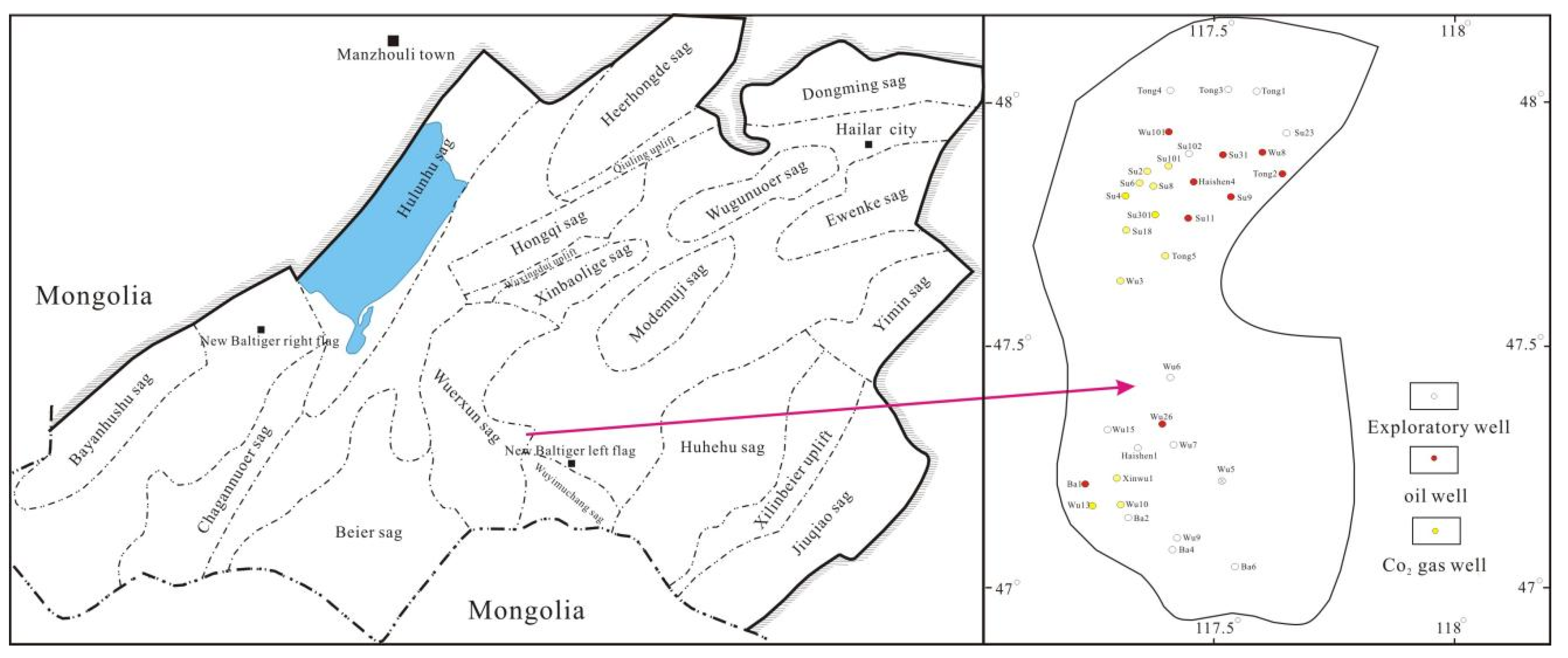

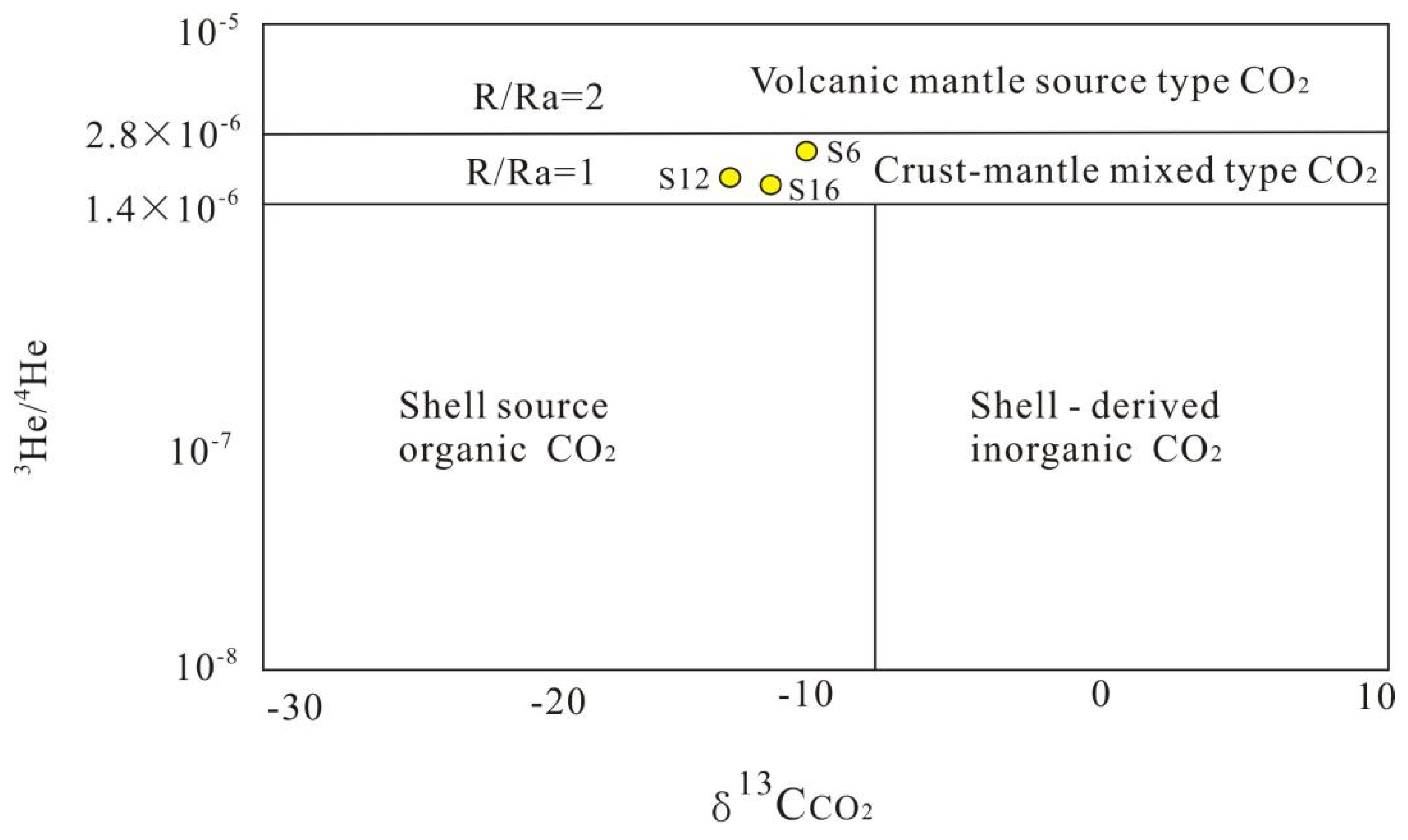
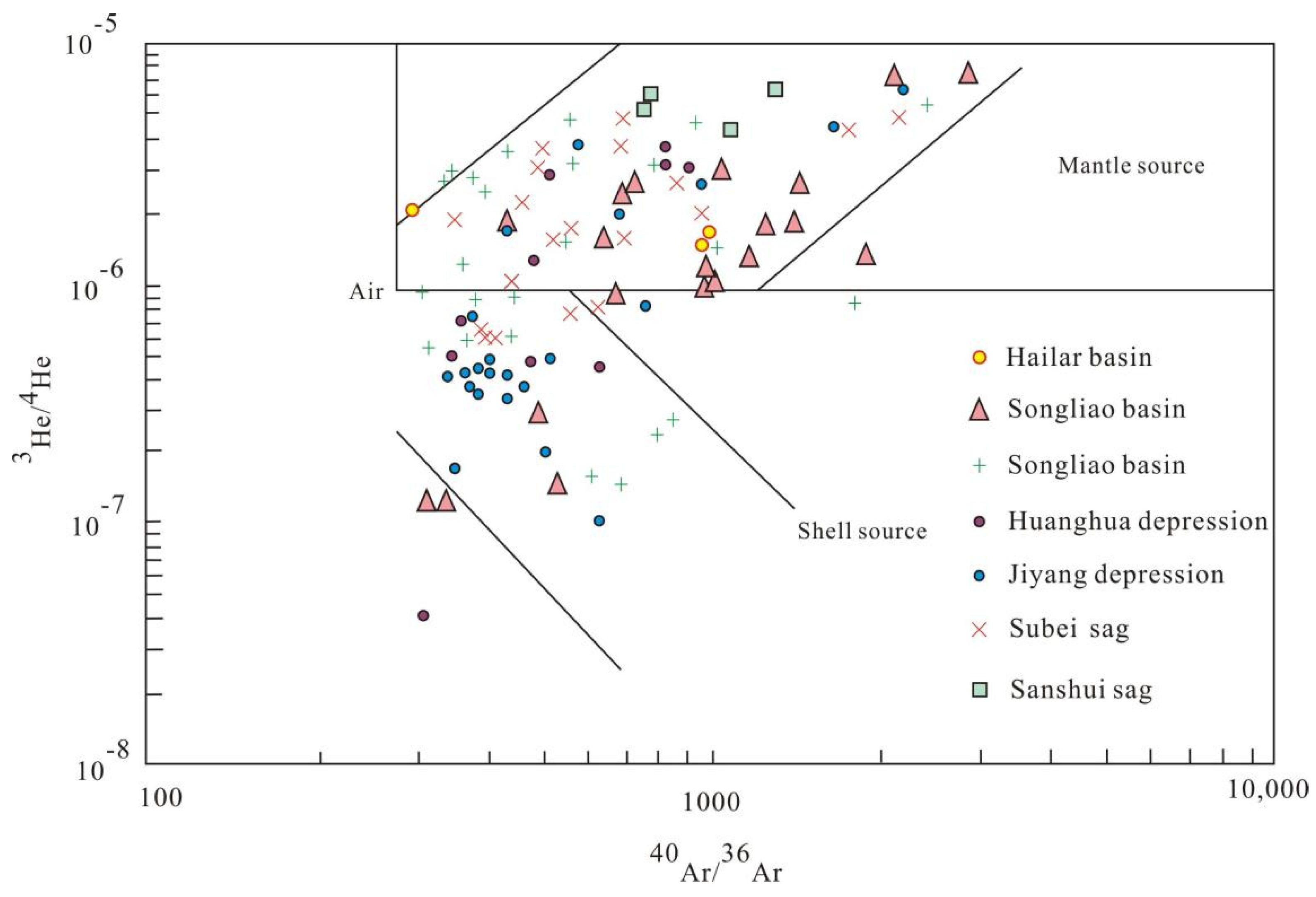

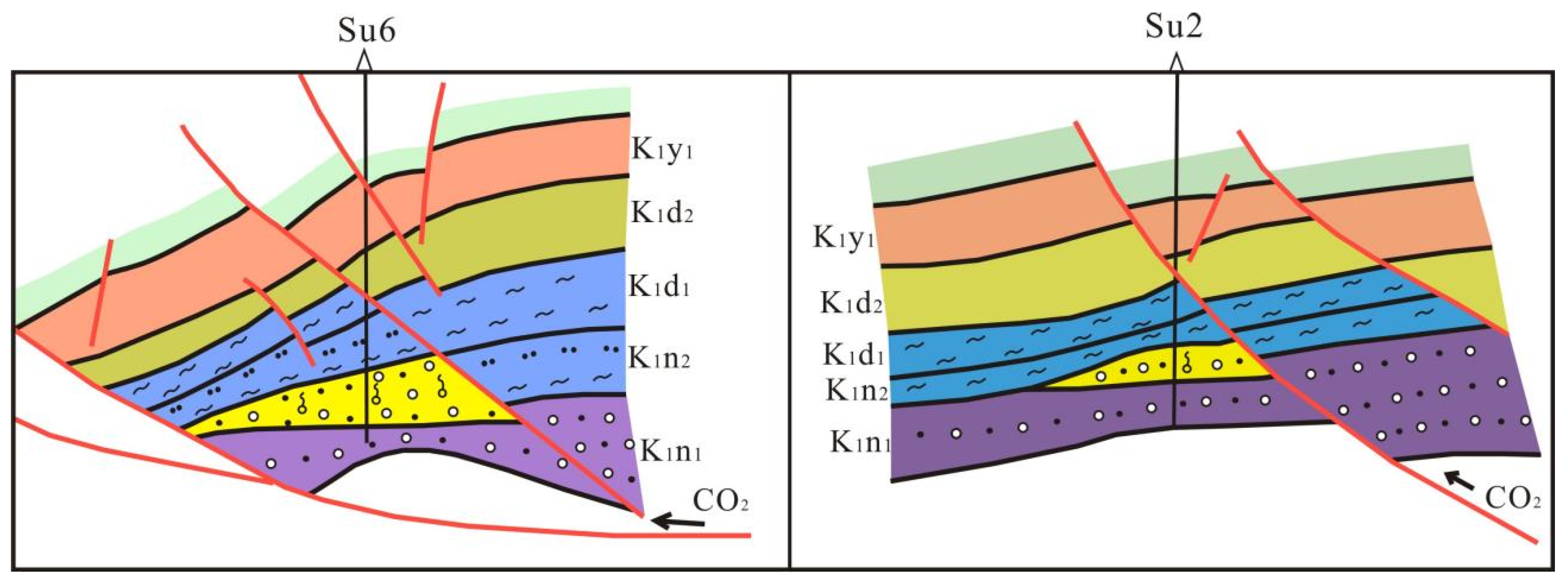
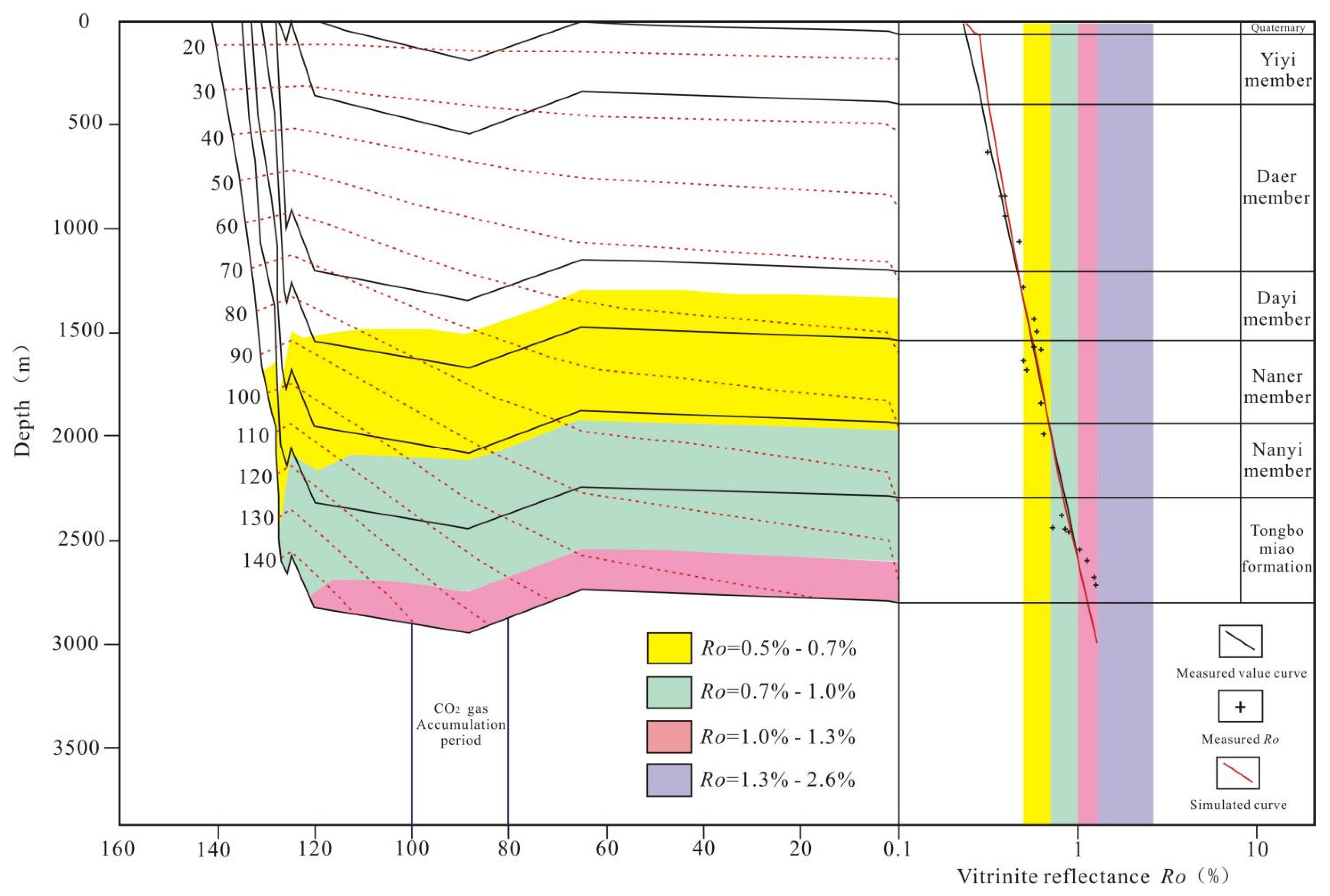
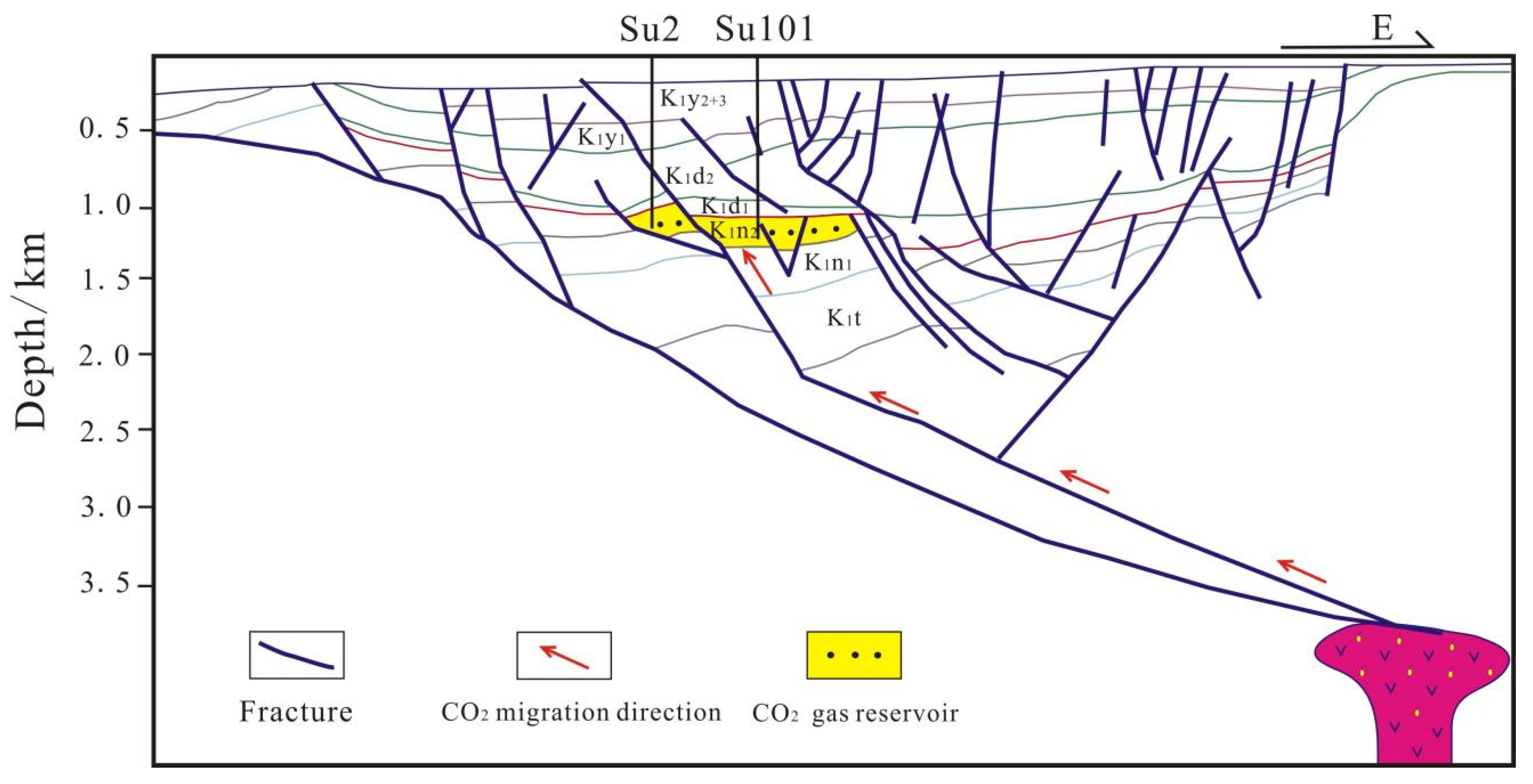
| Well Number | Horizon | Well Section (m) | Gas Composition (%) | δ13CPDB | Yield (m3/d) | ||||||
|---|---|---|---|---|---|---|---|---|---|---|---|
| CH4 | C2H6 | CO2 | He | CH4 | C2H6 | C2H8 | CO2 | ||||
| Su 2 | K1n1 | 1434.0–1449.0 | 0.40 | 96.2 | 0.019 | −56.96 | −41.19 | −31.59 | −11.35 | 22,191 | |
| Su 2 | K1n1 | 1464.0–1490.8 | 0.471 | 96.2 | 0.198 | −47.64 | −41.19 | −31.59 | −8.2 | 2233 | |
| Wu 10 | K1t | 1778.0–1921.6 | 2.16 | 0.18 | 97.6 | 0.003 | −49.25 | −31.57 | −11.36 | 2000 | |
| Wu 13 | Pz | 1732.5–1747.0 | 20.22 | 1.49 | 78.25 | 0.04 | −47.5 | −37.59 | −40.35 | −8.78 | 32,487 |
| Xin Wu 1 | K1n1 | 1557.2–1579.0 | 5.92 | 0.59 | 0.18 | −47.34 | −36.12 | −33.55 | 2300 | ||
| Su 6 | K1n1 | 2010.0–2024.0 | 1.65 | 98.8 | 0.008 | −36.2 | −10.2 | 57,660 | |||
| Well Number | Horizon | Well Depth (m) | Carbon Isotope δ13cpdb | |||||
|---|---|---|---|---|---|---|---|---|
| C1 | CO2 | C2 | C3 | iC4 | nC5 | |||
| Haishen 3 | t | 2068–2094 | −41.6 | −1.4 | −29.9 | −27.4 | −24.5 | −26.4 |
| Su 16 | n2 | 1771.4–1655.8 | −51.5 | −11.1 | −42.1 | −31.9 | ||
| Su 12 | n1 | 1491.8–1508.6 | −52.4 | −13.6 | −43.5 | −35.8 | ||
| Well Number | Horizon | Well Depth (m) | Sampling Container | Analysis Data | |||
|---|---|---|---|---|---|---|---|
| Sample’s R = 3He/4He | R/Ra | 38Ar/36Ar | 40Ar/36Ar | ||||
| Value | |||||||
| Su 12 | n1 | 1491.8–1508.6 | steel cylinder | (1.76 ± 0.05) × 10−6 | 1.26 | 0.1907(9) | 996(6) |
| Su 16 | n2 | 1771.4–1655.8 | steel cylinder | (1.68 ± 0.05) × 10−6 | 1.2 | 0.1900(9) | 916(5) |
| Su 6 | n1 | 2010.0–2024.0 | steel cylinder | (2.08 ± 0.05) × 10−6 | 1.49 | 0.1837(6) | 289.6(5) |
| Well Number | Tong5 | Su 2 | Su 3 | Su 4 | Su 6 | Su 8 | Su 101 | |
|---|---|---|---|---|---|---|---|---|
| Naner section | porosity | 10.0–16.5 | 3.51–10.12 | 6.54–16.87 | 3.13–18.93 | 4.8–13.5 | 10.1–12.8 | 2.81–20.82 |
| (%) | 13.4/57 | 6.8/19 | 9.4/44 | 10.3/60 | 10.1/54 | 11.5/2 | 10.7/114 | |
| permeability | / | / | 0.03–15.9 | 0.05–26.4 | 0.03–6.04 | / | 0.02–25.2 | |
| (10−3 μm2) | 6.2/44 | 1.0/60 | 0.3/54 | 5/114 | ||||
| Nanyi section | porosity | 4.7–16.1 | 8.37–17.02 | / | 8.57–15.58 | / | 8.3–17.4 | 8.21–17.41 |
| (%) | 11.3/19 | 12.2/28 | 12.1/15 | 12.9/67 | 10.7/114 | |||
| permeability | / | 0.05–12.5 | / | 0.19–5.31 | / | / | 0.24–14.9 | |
| (10−3 μm2) | 1.1/28 | 2.0/15 | 6.4/114 | |||||
Publisher’s Note: MDPI stays neutral with regard to jurisdictional claims in published maps and institutional affiliations. |
© 2022 by the authors. Licensee MDPI, Basel, Switzerland. This article is an open access article distributed under the terms and conditions of the Creative Commons Attribution (CC BY) license (https://creativecommons.org/licenses/by/4.0/).
Share and Cite
Cui, J.; Tao, H.; Ren, Z.; Jin, W.; Liu, H.; Meng, Z.; Cheng, K. Genesis and Accumulation Period of CO2 Gas Reservoir in Hailar Basin. Energies 2022, 15, 6183. https://doi.org/10.3390/en15176183
Cui J, Tao H, Ren Z, Jin W, Liu H, Meng Z, Cheng K. Genesis and Accumulation Period of CO2 Gas Reservoir in Hailar Basin. Energies. 2022; 15(17):6183. https://doi.org/10.3390/en15176183
Chicago/Turabian StyleCui, Junping, Hua Tao, Zhanli Ren, Wei Jin, Hao Liu, Zhangyong Meng, and Kezhang Cheng. 2022. "Genesis and Accumulation Period of CO2 Gas Reservoir in Hailar Basin" Energies 15, no. 17: 6183. https://doi.org/10.3390/en15176183
APA StyleCui, J., Tao, H., Ren, Z., Jin, W., Liu, H., Meng, Z., & Cheng, K. (2022). Genesis and Accumulation Period of CO2 Gas Reservoir in Hailar Basin. Energies, 15(17), 6183. https://doi.org/10.3390/en15176183






